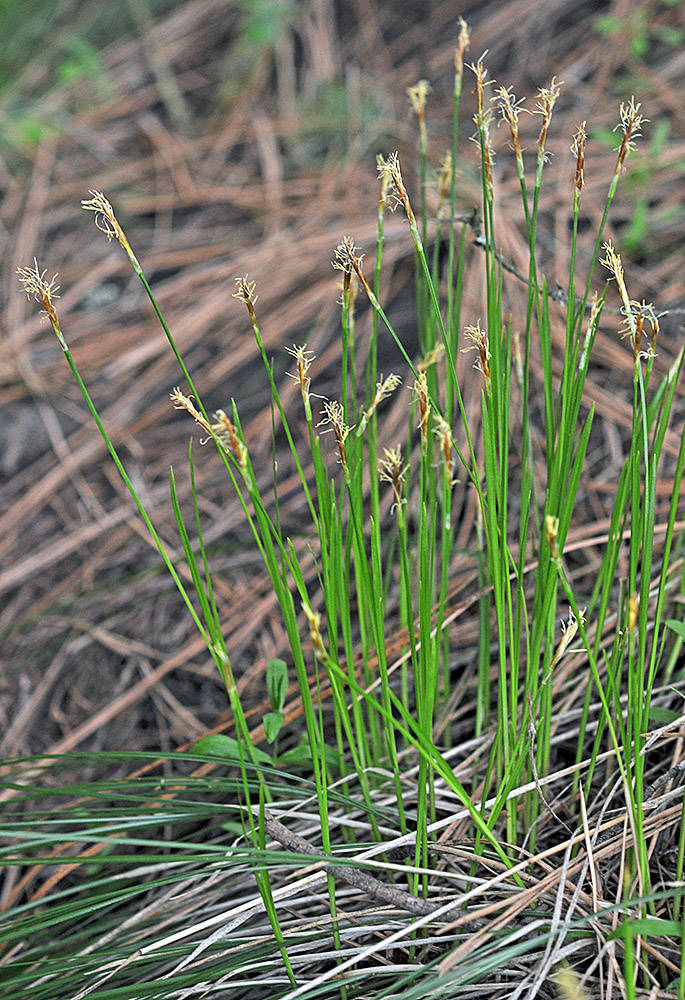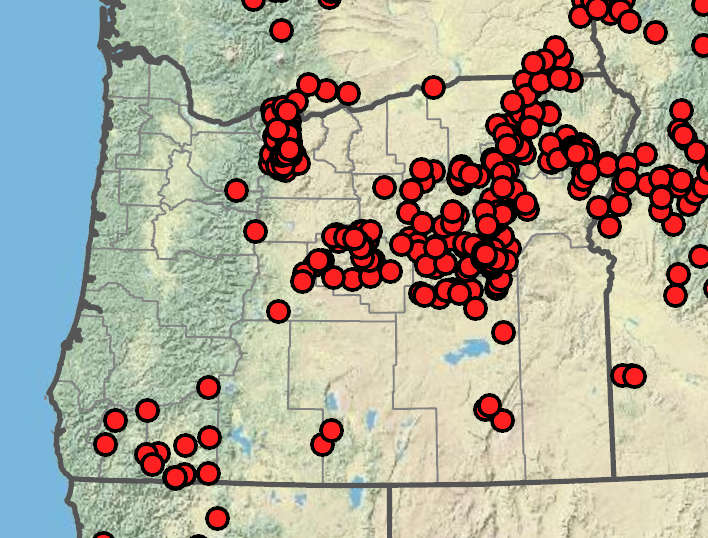|
elk sedge
|
Brainerd's sedge
|
| Plants loosely cespitose or short rhizomatous, with thick, dark, shallow rhizomes; culms 12–50 cm, triangular in cross section. |
Plants densely to loosely cespitose, 5–35 cm tall; plant bases reddish. |
1.1–3.5 mm wide; flat; evergreen; leathery; as long as or longer than the culms. |
blades 1.8–3.8 mm wide, glaucous or seldom green, usually longer than the culms, densely papillose on the lower surface. |
spike solitary, androgynous, lacking inflorescence bracts; male terminal portion 1–2.5 cm long, separated from the 1–3 perigynia by a short internode. |
basal spikes female; more or less hidden among leaf sheaths, bracts of lowest non-basal spikes leaf-like; as long as or longer than the inflorescence; non-basal female spikes 2–6, 4–8 mm long, with 1–4 perigynia; terminal spike male, 0.6–1.3 cm long. |
obovate, rounded at the top, 5–7(8.5) × 1.8–2.8 mm, green; whitish, or brown; beak small; stigmas 3. |
elliptic to obovoid, 4–5.3 × 1.4–2.2 mm, pubescent, with 12–15 veins to at least mid-body as well as 2 ribs, bases with succulent bases that wither when dry; beaks 0.8–1.9 mm long; teeth 0.2–0.5 mm long; stigmas 3. |
trigonous. |
trigonous. |
the lower longer than the perigynia; the upper reduced; more or less brown with paler midrib and margins, pointed to awned. |
shorter than the perigynia; reddish brown with or without narrow white margins; apex acute to acuminate. |
|
|
|
|
|
|
|
Well-drained soils in dry, open, conifer forests, aspen stands, and openings, rarely in sagebrush, on both serpentine and nonserpentine substrates. 100–2500 m. BR, BW, Col, ECas, Lava, Owy, Sisk. CA, ID, NV, WA; north to southeastern British Columbia, east to CO, PA. Native. Carex geyeri is a common ground cover in open forest, especially in northeastern Oregon, recognized by its tough, flat, evergreen leaves from dark, scaly rhizomes. Similar pinegrass, Calamagrostis rubescens, usually has hairy internodes and when in flower it is easily distinguished. Carex geyeri is important food for wildlife and livestock, especially in winter. In southwestern Oregon, C. geyeri can be confused with C. multicaulis, which is densely cespitose and has proportionately shorter, usually involute leaves, and longer, green, leaf-like, lower female scales. |
Upland, open conifer forests, rocky areas, roadsides, cut banks, and clearcuts, generally on excessively drained soils, sometimes on serpentine. 1000–2500 m. Casc, ECas, Sisk. CA. Native. Carex brainerdii is recognized by its upland habitat, hairy perigynia, basal spikes nestled among the leaf bases, and relatively broad, glaucous leaves. When in doubt, use 20× magnification to examine the undersides of the leaves, which are densely papillose. See also C. rossii and C. deflexa var. boottii. |
Flora of Oregon, volume 1, page 202
Barbara Wilson, Richard Brainerd, Nick Otting |
Flora of Oregon, volume 1, page 192
Barbara Wilson, Richard Brainerd, Nick Otting |
C. abrupta, C. agastachys, C. amplifolia, C. angustata, C. aperta, C. aquatilis, C. arcta, C. arenaria, C. atherodes, C. athrostachya, C. atrosquama, C. aurea, C. barbarae, C. bebbii, C. bolanderi, C. brainerdii, C. brevior, C. breweri, C. buchananii, C. buxbaumii, C. californica, C. canescens, C. capillaris, C. capitata, C. chordorrhiza, C. comans, C. comosa, C. concinna, C. concinnoides, C. cordillerana, C. crawfordii, C. cusickii, C. davyi, C. deflexa, C. densa, C. diandra, C. disperma, C. distans, C. douglasii, C. duriuscula, C. echinata, C. exsiccata, C. feta, C. filifolia, C. fissuricola, C. fracta, C. gynocrates, C. gynodynama, C. halliana, C. harfordii, C. hassei, C. haydeniana, C. hendersonii, C. heteroneura, C. hirsutella, C. hirta, C. hoodii, C. hystericina, C. idahoa, C. illota, C. infirminervia, C. inops, C. integra, C. interior, C. interrupta, C. jonesii, C. kelloggii, C. klamathensis, C. kobomugi, C. laeviculmis, C. lasiocarpa, C. leporina, C. leporinella, C. leptalea, C. leptopoda, C. limosa, C. livida, C. longii, C. luzulina, C. lyngbyei, C. macrocephala, C. macrochaeta, C. media, C. mendocinensis, C. mertensii, C. mesochorea, C. micropoda, C. microptera, C. multicaulis, C. nardina, C. nebrascensis, C. nervina, C. neurophora, C. nigricans, C. nudata, C. obnupta, C. pachycarpa, C. pachystachya, C. pansa, C. paysonis, C. pellita, C. pelocarpa, C. pendula, C. petasata, C. phaeocephala, C. pluriflora, C. praeceptorum, C. praegracilis, C. praticola, C. preslii, C. pumila, C. raynoldsii, C. retrorsa, C. rossii, C. saxatilis, C. scabriuscula, C. scirpoidea, C. scoparia, C. scopulorum, C. serpenticola, C. serratodens, C. sheldonii, C. simulata, C. spectabilis, C. stipata, C. straminiformis, C. subbracteata, C. subfusca, C. subnigricans, C. sychnocephala, C. tahoensis, C. tiogana, C. tribuloides, C. tumulicola, C. unilateralis, C. utriculata, C. vallicola, C. vernacula, C. vesicaria, C. viridula, C. vulpinoidea, C. whitneyi, C. zikae |
C. abrupta, C. agastachys, C. amplifolia, C. angustata, C. aperta, C. aquatilis, C. arcta, C. arenaria, C. atherodes, C. athrostachya, C. atrosquama, C. aurea, C. barbarae, C. bebbii, C. bolanderi, C. brevior, C. breweri, C. buchananii, C. buxbaumii, C. californica, C. canescens, C. capillaris, C. capitata, C. chordorrhiza, C. comans, C. comosa, C. concinna, C. concinnoides, C. cordillerana, C. crawfordii, C. cusickii, C. davyi, C. deflexa, C. densa, C. diandra, C. disperma, C. distans, C. douglasii, C. duriuscula, C. echinata, C. exsiccata, C. feta, C. filifolia, C. fissuricola, C. fracta, C. geyeri, C. gynocrates, C. gynodynama, C. halliana, C. harfordii, C. hassei, C. haydeniana, C. hendersonii, C. heteroneura, C. hirsutella, C. hirta, C. hoodii, C. hystericina, C. idahoa, C. illota, C. infirminervia, C. inops, C. integra, C. interior, C. interrupta, C. jonesii, C. kelloggii, C. klamathensis, C. kobomugi, C. laeviculmis, C. lasiocarpa, C. leporina, C. leporinella, C. leptalea, C. leptopoda, C. limosa, C. livida, C. longii, C. luzulina, C. lyngbyei, C. macrocephala, C. macrochaeta, C. media, C. mendocinensis, C. mertensii, C. mesochorea, C. micropoda, C. microptera, C. multicaulis, C. nardina, C. nebrascensis, C. nervina, C. neurophora, C. nigricans, C. nudata, C. obnupta, C. pachycarpa, C. pachystachya, C. pansa, C. paysonis, C. pellita, C. pelocarpa, C. pendula, C. petasata, C. phaeocephala, C. pluriflora, C. praeceptorum, C. praegracilis, C. praticola, C. preslii, C. pumila, C. raynoldsii, C. retrorsa, C. rossii, C. saxatilis, C. scabriuscula, C. scirpoidea, C. scoparia, C. scopulorum, C. serpenticola, C. serratodens, C. sheldonii, C. simulata, C. spectabilis, C. stipata, C. straminiformis, C. subbracteata, C. subfusca, C. subnigricans, C. sychnocephala, C. tahoensis, C. tiogana, C. tribuloides, C. tumulicola, C. unilateralis, C. utriculata, C. vallicola, C. vernacula, C. vesicaria, C. viridula, C. vulpinoidea, C. whitneyi, C. zikae |
| |
BC,
CA,
OR,
WA
CalFlora,
CalPhotos,
Flora NW,
PNW Herbaria
WildflowerSearch
iNaturalist (observations)
USDA Plants Database





